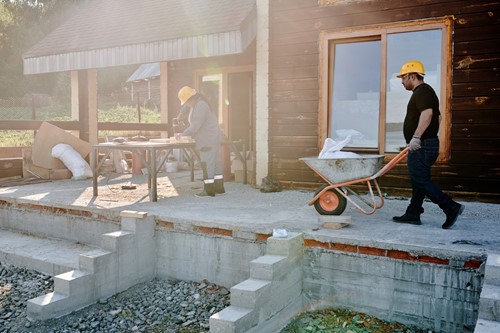
In both existing homes and new construction, there are several common types of foundations for houses. Each has their advantages and disadvantages, including specific maintenance requirements and climate-specific considerations.
Whether you’re building a new home or want to learn more about how to care for your existing home, it’s worth exploring the three major types of foundations used for houses:
Basement foundations are essentially holes dug beneath the house, matching most or all of the ground-level square footage. Builders use concrete footings around the edge of the basement space as a frame for the foundation, then follow with beams, walls and a concrete slab at the bottom.
Basement foundations can add extra living space to the home, potentially doubling the square footage if finished. Otherwise, unfinished basements serve as valuable storage space and shelter in case of extreme weather.
Concrete slab foundations are made of a simple, flat layer of concrete situated slightly below the surface of the ground. This is one of the simplest foundation types to install, involving a wire mesh and reinforcing bars within the concrete for extra stability.
Slab foundations are best for warmer regions, as frozen ground can cause cracks and shifts in the concrete. However, in the right conditions, a slab foundation will not develop weak spots or crumble over time.
Crawl space foundations have characteristics of both a basement and a slab foundation. They’re built using small concrete footings called stem walls, which create a slightly elevated space beneath the home. While you can’t use a crawl space as living space, it can be perfect for storage and access to plumbing or electrical wiring.
Crawl space foundations can help keep the home safe from flood damage, earthquake damage and termites. One disadvantage of this foundation type is the vulnerability to mold, mildew and pests who might like to make the shelter their home.
There are other types of foundations, like wood foundations and pier foundations, which are typically more specific to certain regions and types of home. There are also variations of the foundations found in this article, such as slab on grade foundations and daylight basements.
Regardless, the more you know about these three common types of concrete foundation, the more prepared you’ll be to take care of your own - whether in your current home or brand-new construction.

“I sell your home like it's mine”
A licensed real estate salesperson since 2016, Rob is affiliated with the Briarcliff Manor office of Corcoran Legends Realty. He serves buyers, sellers, renters, in Westchester, Rockland, and Putnam counties. Rob, a native of New York and Westchester County for most of his life, brings an extensive local knowledge of both residential and commercial properties to the table. His experience includes a wide range of property types – single-family, multi-family, condos and mixed use. “Hard to sell” properties is where Rob really excels. “There’s no problem that cannot be solved.”
Rob is certified for many different disciplines in real estate. Cartus Relocation Network Agent, AARP Agent, National Tenants Network (NTN) Agent, Green certified and Pricing Strategies Master. In addition, Rob has completed the Leader’s Edge Advanced training to better serve his clients. Rob has been both associate of the month and top closed dollar agent.
When you work with Rob, you get the feeling you’re his only client. Numbers don’t count, you do. Clients always come first. Each transaction is handled as if it were his own home. Rob strives to make the process as seamless as possible and takes care of all the details, no matter how small. His clients rave about his above-and-beyond service and prompt informative communication. Rob is easy going, friendly, and patient. However he can be a determined and aggressive negotiator when the need arises.
When not out actively working on behalf of his clients, Rob spends time with his wife and two teenage daughters. A devoted supporter of community he sits on several local boards and volunteers for numerous locale nonprofit organizations. He enjoys cycling, hiking, kayaking and winter skiing.
“May your price be right, and your sale be swift!”